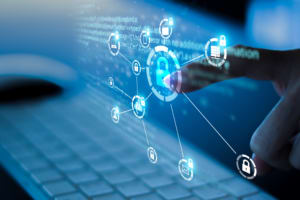Physical Security and Cybersecurity: How They Work Together

Physical security and cybersecurity measures have traditionally been viewed as separate efforts. However, integrating physical security and cybersecurity can improve threat detection and response capabilities, cut costs, and increase overall security posture.
To fully protect your sensitive assets, all your security programs must communicate. Cybersecurity experts and physical security professionals are concerned with risk management and stand a better chance of keeping potential bad actors out by working together.
What is the Importance of Physical Security and Cybersecurity?
Through the adoption of the Internet of Things (IoT) and Industrial Internet of Things (IIoT) devices, the world is becoming increasingly interconnected. This mesh of cyber-physical systems (CPS) expands the attack surface, making physical and digital security essential to prevent cyber physical attacks.
Today, even commonplace devices like surveillance cameras can be targeted by cybercriminals. Protecting these devices is no longer just a technology concern; it involves safeguarding people, processes, and physical infrastructure.
Incidents involving the convergence of cyber and physical security fall into two main categories:
Cyberattacks on Physical Systems:
These incidents involve cybersecurity threats targeting physical infrastructure, such as video management systems, access control devices, or industrial control systems. Attackers aim to compromise these systems to gain unauthorized access, disrupt operations, or cause harm.
Physical Systems Used in Cyberattacks
In this scenario, physical devices or systems become tools for cyberattacks. For instance, insecure Internet of Things (IoT) devices can be hijacked and used as part of botnets to launch a distributed denial of service attack. Safeguarding hardware like servers, computers, and networked technology from unauthorized physical access or tampering is crucial to prevent data breaches and cyber-system disruptions.
What Are the Key Components of Physical Security?
It takes the implementation of many physical security measures to keep sensitive assets safe, such as:
1. Access Control Systems
Access control systems, including key card door locks and cloud-based solutions, are vital in restricting access to specific areas, such as exterior entry doors, server rooms, and HR offices. They ensure that only authorized individuals can enter, bolstering security and confidentiality.
2. Perimeter Security
Perimeter security involves fences, vehicle barriers, and access control points. These measures are designed to prevent unauthorized access to a facility, creating the first line of defense against potential threats.
3. Surveillance Systems
Surveillance systems, such as CCTV cameras, monitor and record activities in and around a facility, enhance security, and aid investigations by providing a detailed visual record.
4. Intrusion Detection Systems
Intrusion detection systems are crucial for alerting security personnel to unauthorized access attempts. They enable a rapid response and the swift initiation of security protocols.
5. Security Lighting
Security lighting serves multiple purposes — it helps deter intruders while ensuring proper night visibility. It acts as a deterrent and enhances overall safety.
6. Security Personnel
Trained security personnel provide a human presence in your security framework. They assist in monitoring and responding to security threats, enhancing the proactive security posture.
7. Security Alarms
Security alarms are essential for detecting breaches and triggering alerts. These alarms prompt immediate action and facilitate a quick and effective response to security incidents.
What Are the Key Components of Cybersecurity?
Each of these components plays a pivotal role in ensuring the integrity of important assets:
1. Firewalls
Firewalls protect networks by controlling incoming and outgoing traffic, preventing unauthorized access. They act as a digital barrier, scrutinizing data packets and making real-time decisions to allow or block them based on defined security policies.
2. Antivirus and Antimalware Software
These tools identify and remove malicious software. By continuously scanning files and systems for known malware and employing heuristics to detect suspicious behavior, antivirus, and antimalware software provide a crucial layer of defense against evolving cyber threats.
3. Intrusion Detection and Prevention Systems (IDPSs)
IDPSs monitor network traffic and detect suspicious activities, helping prevent cyberattacks. They analyze network packets and patterns to identify potential threats and respond swiftly.
4. Secure Sockets Layer/Transport Layer Security (SSL/TLS)
SSL/TLS protocols encrypt data during transmission, ensuring the confidentiality and integrity of information. When data is transferred over the internet, SSL/TLS protocols create a secure tunnel, protecting sensitive information from eavesdropping and tampering.
5. Two-Factor Authentication (2FA)
2FA adds an extra layer of security by requiring users to provide two different authentication factors to access systems. This dual verification process significantly enhances access security by combining something the user knows (like a password) and something the user has (like a smartphone).
6. Security Awareness Training
Training employees on cybersecurity best practices helps reduce human error, a common cause of security breaches. By conducting security awareness training for staff, you can teach them about the latest threats, safe online behavior, and how to identify potential risks, organizations empower their workforce to be vigilant defenders of cybersecurity.
7. Regular Updates and Patch Management
Keeping software, operating systems, and hardware up to date with the latest security patches is crucial for protecting against vulnerabilities. Regular updates and patch management ensure that known security flaws are addressed promptly.
What Are the 5 Core Function of a Cybersecurity Framework?
The National Institute of Standards and Technology (NIST) is a US-based agency that develops cybersecurity standards for other federal agencies and the general public. Their Cybersecurity Framework provides valuable insight into what businesses should consider when building out their framework:
1. Identify
The first step to developing a cybersecurity framework is identifying and categorizing assets, risks, and vulnerabilities. It involves cataloging every digital and physical asset, evaluating potential threats, and understanding where vulnerabilities may exist.
2. Protect
The next step focuses on implementing safeguards and security measures to protect assets and data. Employ encryption, access controls, and other security mechanisms to shield assets from unauthorized access and tampering.
3. Detect
It’s also imperative to establish mechanisms to detect and respond to security incidents promptly. Put proactive monitoring and alert systems in place to identify and respond to abnormal activities or breaches in real time.
4. Respond
A detailed incident response plan in place ensures you’ll be able to address security incidents effectively and methodically. This plan should include detailed response protocols, communication guidelines, and reporting procedures, as well as a map of the different stakeholders involved and what their responsibilities are.
5. Recover
In the event a security breach is successful, it’s important to have a recovery response plan in place to minimize business disruptions. Your disaster recovery plan should detail your strategies to bring systems, data, and operations back to full functionality.
How Do Physical Security and Cybersecurity Work Across These 5 Functions?
A robust cybersecurity framework requires close and constant collaboration between physical and cybersecurity practitioners. Both have vital roles to play in every stage.
For example, physical security protects against unauthorized access (Protect), detects breaches through surveillance and access controls (Detect), and provides a human response to incidents (Respond). Meanwhile, cybersecurity safeguards digital assets (Protect), detects cyber threats (Detect), and responds to and recovers from cyberattacks (Respond and Recover).
What Is the Interplay Between Physical Security and Cybersecurity?
Physical and cybersecurity professionals work closely at all times, but it’s most evident in Cyber-Physical Systems (CPS). These integrated systems, which use computer algorithms to control devices and mechanisms in the physical world, are common in smart infrastructures, making them attractive targets. For instance, a successful attack on an apartment building’s CPS-enabled HVAC system could create serious consequences for residents, especially during extreme weather. Identifying and limiting vulnerabilities requires physical security measures (e.g., limiting access to the building and requiring identification for maintenance workers) alongside cybersecurity tactics that protect against cyberattacks.
What Are the Benefits of Integrating Physical Security and Cybersecurity?
An integrated security approach involving physical and cybersecurity enhances protection at every level, making your defenses more robust and adaptable.
Improved Threat Detection and Response Capabilities
By combining physical and cybersecurity, organizations gain a more comprehensive understanding of potential threats, allowing quicker response times and more effective threat mitigation.
Enhanced Protection of Sensitive Data
Combined security measures offer a comprehensive shield for sensitive data, reducing the risk of breaches and unauthorized access. This integrated approach ensures that both the physical and digital aspects of data security work in tandem.
Increased Overall Security Posture
Integration strengthens the overall security posture, making it more resilient to evolving threats and bolstering your ability to adapt to new challenges.
Real-Time Monitoring and Analytics
By continuously monitoring physical and digital security, organizations can gather valuable data to inform their security strategies and respond more effectively to potential threats.
Cost Savings
Physical and cybersecurity teams should collaborate to avoid redundant investments and duplicate efforts, leading to cost savings and improved resource allocation. It is important to note that a breach could result in significant financial and reputational consequences for a company.
Best Practices for Integrating Physical Security and Cybersecurity
Integrating physical and cybersecurity effectively requires the implementation of several best practices. First, it's crucial to establish clear communication channels and promote collaboration between the physical and cybersecurity teams. It ensures that both departments share common goals and strategies, resulting in a more unified and robust security approach.
Second, conducting regular cybersecurity risk assessments is essential. You can take proactive measures to implement appropriate controls by identifying potential risks and vulnerabilities. These controls should address physical and cybersecurity threats, creating a more comprehensive defense.
Finally, prioritize regular staff training and awareness programs. Educating employees on security best practices is paramount. Stress the significance of physical and cybersecurity, ensuring staff understand their role in maintaining a secure environment. This awareness empowers employees to proactively prevent security breaches and incidents, contributing to your overall security posture.
Prioritize Integration of Physical Security and Cybersecurity with LenelS2
Incorporating LenelS2's advanced security and access control solutions can streamline physical and cybersecurity integration. LenelS2 offers various products and services to enhance security and protect people and assets across multiple industries. By partnering with LenelS2, you can bolster your overall security framework and adapt to the interconnected nature of modern security challenges. Request a free demo to learn more!




